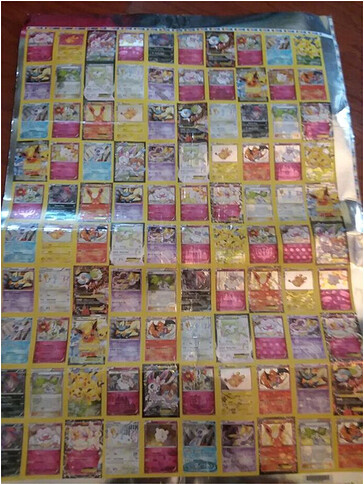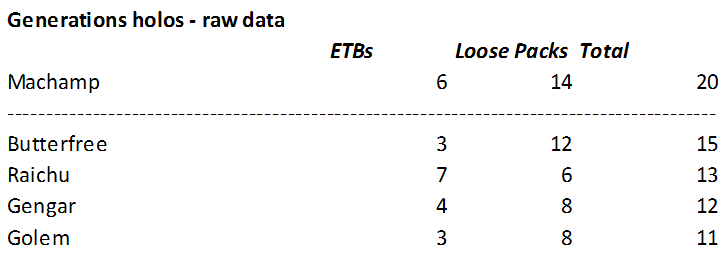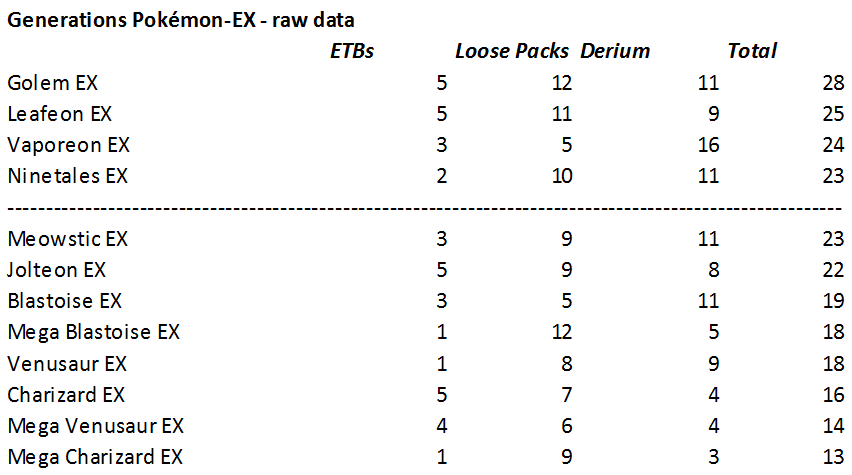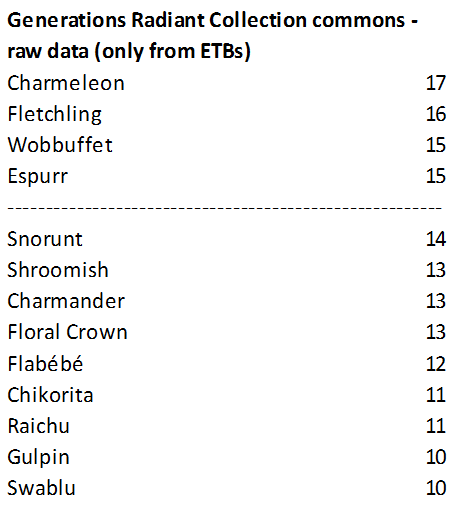Generations
This guide is largely based on analyzing pack opening videos on YouTube. I followed the strategy of only looking a complete box openings for main series sets, not just because of the possibility that loose packs can be weighed for earlier sets and possibly otherwise tampered with, but because the degree of randomness is higher for loose packs. A box can be assumed to usually contain 36 packs in a row from the packaging line, leading to very “sharp” statistics. In the case of the EX series sets, the contents of a booster box is so predictable that you can usually tell whether a Gold Star will take the place of a Pokémon-ex or of a holo in a box.
For the special sets that don’t come in booster boxes, I don’t have this option, so for most sets I relied on videos of ETBs being opened. The degree of randomness is higher, and so is the uncertainty regarding the pull rates.
Generations is a special case, since the ETBs were only released very late, and most of the videos available on YouTube are from loose packs. For this reason I am using a triple sample to analyze the pull rates:
- 170 packs from ETBs
- 516 packs from large openings of loose packs
- the summary of a 500 pack opening by Derium. This sample only includes data on the ultra rares, not on the holos.
Before looking at the results, let’s look at the contents of a Generations pack. Each pack contains 4 commons/Basic Energies (they were printed on the same sheet), 2 uncommons, 1 reverse, 1 common from the Radiant Collection, 1 uncommon or ultra rare from the Radiant Collection, and the rare slot, which can be either a non-holo rare, a holo rare, a Pokémon-EX or a full art (Articuno or Zapdos). A photo exists of the Radiant Collection uncommons/ultra rares sheet; each uncommon is printed 6 times on the sheet, each ultra rare 4 times:
Back to the samples from YouTube. For the sake of comparison with sets that came in booster boxes, I am giving the ratios as “box” ratios, i.e. pulls per 36 packs. Based on the values shown below, the estimate for my model is 3.80 holos, 7.40 Pokémon-EX and 0.80 full arts per 36 packs, making for a total of 12 “hits” per 36 packs:
An alternative model would be to go back to the 216 pack sequence length instead of the 180 pack one and assume 3.75 holos, 7.50 Pokémon-EX and 0.75 full arts per 36 packs. This would be kind of neat as it would mean the odds of getting a Pokémon-EX from the main set are twice as high as getting a holo.
The rarity table thus looks as follows, with SPa denoting the Radiant Collection uncommons/ultra rares sheet, and SPb the Radiant Collection commons sheet.
The ratios per box are provided solely for comparison with other sets.
Some things need to be said about the individual sheets. The raw data for the holos and Pokémon-EX is given below (for the rares and full arts my assumption is that they are all printed on their sheets an equal number of times, and the data doesn’t suggest anything to the contrary):
For the Radiant Collection, the raw data is shown below for both sheets:
The raw data for the uncommons/ultra rares sheet is interesting because it can be compared to the actual sheet. With the high degree of randomness prevalent outside of booster boxes, the cards known to be the least common (the seven ultra rares) don’t all appear the fewest times in the sample; two uncommons - Slurpuff and Swirlix - appear fewer times than some of these ultra rares. The upshot from that is to be cautious with data on individual cards from special sets when the sample isn’t coming from booster boxes (and to be cautious with data on individual cards in general).
A word on the commons from the main set: The small number of cards in total (meaning the individual ones appear up to 5 times on the sheet), the fact that there are only 4 commons per pack, and a tendency I observed for cards to get flipped around and appear outside of the sheet order means reconstructing the commons sheet to my own satisfaction of accuracy would be too time-consuming. I do however have an approximate idea how the sheet looked and am very confident each Basic Energy card appeared 3 times on it. I am also relatively confident that the only common to appear only 4 times on the sheet is Clefairy.
For the reverses, I am assuming the reverse Basic Energies are printed on the same sheet as the other reverses. The patterns on the other cards (Energies for the Pokémon, Pokéballs for the Trainers) are not part of the actual holofoil, but printed on. I did not look at the reverses myself, but the number of reverse Basic Energies shown in the summary of Derium’s video is consistent with these reverses appearing only 1 time on the 121 card sheet. As to the other 8 reverses to which this also applies, I don’t know which ones they might be.
As a final note, there are some error packs where the Radiant Collection uncommon/ultra rare is accidentally replaced by a non-holo rare from the main set. Not knowing how prevalent this error is, I did not make a separate rarity table for it. But it does have an interesting implication: With the ETBs only being released very late, they may have come from a later print run. Having accidentally “disposed” of some non-holo rares in packs, that may have left an overhang of “hits” and let to the ratios being changed, explaining why the sample of ETB packs shows a slightly higher ratio of “hits”. This is pure speculation, however, and the observed outcome is not necessarily statistically relevant.
Edit 2024/02/17: Added some text explaining why the reverse Basic Energies are in my opinion printed on the same sheet as the other reverses.
Edit 2024/03/24: Changed sequence length from 180 to 360. This has no impact on pull rates.






